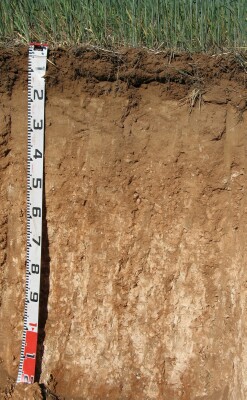Victorian Horticulture Soils - Calcarosols
Back to: Victorian Horticulture Soils
Calcarosols (often called ‘mallee loams’,‘mallee sands’ or ‘calcareous earths’) are formed on calcareous aeolian (wind-blown) sediments. They generally have a small, gradual increase in clay content with depth (i.e. not a strong texture contrast between surface soil and subsoil as compared to Sodosols). They are calcareous throughout and usually have visible accumulations of calcium carbonate (lime) in the soil profile, either in soft form, in nodules or as hard blocks. The soil profile is typically alkaline throughout and sodicity and salt levels can be high in the deeper subsoils.
Distribution
| Calcarosols are widespread soils in the Mallee and Wimmera regions of Victoria. They vary quite considerably in terms of soil texture in the upper part of the soil profile - ranging from those dominated by sands to those that are clayey throughout (i.e. heavy-textured). Medium-textured Calcarosols are most commonly used for horticulture, as well as Calcareous sands that are described in the Sandy soils section. |  |
| Medium-textured Calcarosols predominate in the central and northern Mallee region where east-west dunes alternate with broad swales. The soils in the swales (between dunes) and broad north-south trending ridges generally have sand to sandy loam surface soils overlying clay loam to light clay subsoils that are often sodic. Soil pit site LWA2 is an example of a medium-textured Calcarosol near Chinkapook. Calcareous sands are most common on the east-west dunes themselves and are typically sandy throughout, or at least in the upper 50 cm of the soil profile. |  A Calcarosol near Chinkapook |
Management Considerations
General
Soil texture has a significant influence on agronomic performance. Sands are easily worked, but they have low fertility reserves and are very prone to wind erosion. Medium to heavier textured Calcarosols are more fertile and less erodible, but can be more prone to salting (particularly in lower parts of the landscape) and structural decline when over-cultivated.
Whole Profile
Management strategies for all soils should include: increasing organic matter levels in the surface soil, minimising the degradation of soil aggregates and porosity, promoting the development of stable biopores, and breaking up any hardpans. Less frequent tillage, using less aggressive implements and working the soil at its optimum moisture content, can all assist in maintaining soil aggregation and porosity, as well as reducing organic matter breakdown.
For most Calcarosols, the soil profile is strongly to extremely alkaline throughout. This indicates that phosphorus and trace elements such as iron, manganese, copper and zinc may be poorly available to plants. In some areas, the immediate surface horizon may be neutral to slightly alkaline, but alkalinity can increase significantly deeper down the profile.
Surface (A) Horizons
The surface soil of many Calcarosols is often well suited as a seedbed – as the surface condition can be soft and the soil has a weak consistence (i.e. it does not become excessively hard) and is reasonably friable. Deeper surface horizons are usually most suited to horticulture. If they are shallow they should be protected as much as possible from wind and water erosion and over-cultivation.
Improving organic matter levels and maintaining surface cover is beneficial. Increasing organic matter levels will assist in improving surface soil aggregation, water holding capacity and ameliorating hardsetting conditions. Organic matter levels will decline under cropping, but can be improved by adopting practices such as utilisation of compost and manures, minimum tillage, residue retention, and utilising pasture rotations.
Tillage of heavier-textured Calcarosols should be avoided if the soil is wet (i.e. wetter than the plastic limit). At such moisture conditions, excessive tillage, trafficking or over-stocking could result in some structural damage (e.g. compaction). Ideally, tillage should take place on clayey soils when the soil is drier than the plastic limit – down to at least the tillage depth.
Hardsetting surface horizons that disperse in water (particularly after remoulding) can occur, particularly on heavier-textured surface horizons. This indicates that dispersion may occur if the soil is tilled in a moist to wet condition. Also, raindrop action on bare surface soil may also promote dispersionand result in surface sealing or surface crust formation. Surface cover should be maintained as much as possible to protect against raindrop damage.
The use of gypsum may also assist in ameliorating surface soil condition if dispersion occurs.
Sandy surface horizons allow rapid water infiltration, but this may slow down deeper in the soil profile if the subsoil becomes more clayey and sodic. Water holding capacity is lower in the sandier surface horizons. It is important to maintain surface cover as sandy surface soils are most prone to wind erosion.
Subsoil (B) Horizons
Subsoils are often sodic and dispersive. This is likely to result in restricted root and water movement into the subsoil.
Boron levels can often be quite high in very strongly alkaline subsoils. This can affect the growth of boron-sensitive species. The level of soluble salts can also be high in the subsoil, which will restrict the growth of salt-sensitive species. Excessive soil salinity can affect the plant's ability to take up water and can also have a toxic effect on plants.


